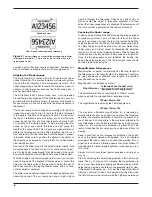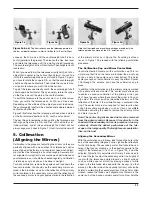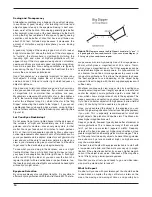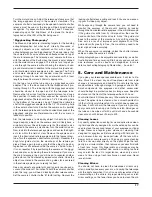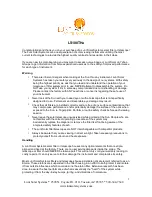
11
scope on the R.A. axis until the counterweight shaft is hori-
zontal (parallel to the ground). Then loosen the Dec. lock lever
and rotate the telescope until it is pointing straight overhead.
The counterweight shaft is still horizontal. Then retighten both
lock levers.
What if you need to aim the telescope directly north, but at an
object that is nearer to the horizon than Polaris? You can’t do
it with the counterweight down as pictured in Figure 1. Again,
you have to rotate the scope in R.A. so that the counterweight
shaft is positioned horizontally. Then rotate the scope in Dec.
so it points to where you want it near the horizon.
To point the telescope directly south, the counterweight shaft
should again be horizontal. Then you simply rotate the scope
on the Dec. axis until it points in the south direction.
To point the telescope to the east or west, or in other direc-
tions, you rotate the telescope on its R.A. and Dec. axes.
Depending on the altitude of the object you want to observe,
the counterweight shaft will be oriented somewhere between
vertical and horizontal.
Figure 9 illustrates how the telescope will look when pointed
at the four cardinal directions: north, south, east and west.
The key things to remember when pointing the telescope are
that a) you only move it in R.A. and Dec., not in azimuth or lat-
itude (altitude), and b) the counterweight and shaft will not
always appear as it does in Figure 1. In fact it almost never will!
5. Collimation
(Aligning the Mirrors)
Collimation is the process of adjusting the mirrors so they are
perfectly aligned with one another. Your telescope’s optics
were aligned at the factory, and should not need much adjust-
ment unless the telescope is handled roughly. Accurate mir-
ror alignment is important to ensure the peak performance of
your telescope, so it should be checked regularly. Collimation
is relatively easy to do and can be done in daylight.
To check collimation, remove the eyepiece and look down the
focuser drawtube. You should see the secondary mirror cen-
tered in the drawtube, as well as the reflection of the primary
mirror centered in the secondary mirror, and the reflection of
the secondary mirror (and your eye) centered in the reflection
of the primary mirror, as in Figure 10a. If anything is off-cen-
ter, as in Figure 10b, proceed with the following collimation
procedure.
The Collimation Cap and Mirror Center Mark
Your AstroView 6 EQ comes with a collimation cap. This is a
simple cap that fits on the focuser drawtube like a dust cap,
but has a hole in the center and a silver bottom. This helps
center your eye so that collimation is easy to perform. Figures
10b through 10e assume you have the collimation cap in
place.
In addition to the collimation cap, the primary mirror is marked
with a circle at its exact center. This “center mark” allows you
to achieve a precise collimation of the primary mirror; you
don’t have to guess where the center of the mirror is. You sim-
ply adjust the mirror position (described below) until the
reflection of the hole in the collimation cap is centered in the
ring. The center mark is also required for best results when
using other collimating devices, such as Orion’s LaserMate
Collimator, obviating the need to remove the primary mirror
and mark it yourself.
Note: The center ring sticker need not ever be removed
from the primary mirror. Because it lies directly in the
shadow of the secondary mirror, its presence in no way
adversely affects the optical performance of the tele-
scope or the image quality. That might seem counterintu-
itive, but its true!
Aligning the Secondary Mirror
With the collimation cap in place, look through the hole in the
cap at the secondary (diagonal) mirror. Ignore the reflections
for the time being. The secondary mirror itself should be cen-
tered in the focuser drawtube, in the direction parallel to the
length of the telescope. If it isn’t, as in Figure 10b, it must be
adjusted. Typically, this adjustment will rarely, if ever, need to
be done. It helps to adjust the secondary mirror in a brightly lit
room with the telescope pointed towards a bright surface,
such as white paper or wall. Also placing a piece of white
paper in the telescope tube opposite the focuser (in other
words, on the other side of the secondary mirror) will also be
helpful in collimating the secondary mirror. Using a 2mm Allen
wrench, loosen the three small alignment set screws in the
center hub of the 4-vaned spider several turns. Now hold the
Figure 9a,b,c,d:
This illustration shows the telescope pointed in
the four cardinal directions: (a) North, (b) South, (c) East, (d) West.
Note that the tripod and mount have not been moved; only the
telescope tube has move on the R.A. and Dec. axis.
Figure 9a
Figure 9b
Figure 9c
Figure 9d
Summary of Contents for AstroView 6 EQ 9827
Page 19: ...19 ...






